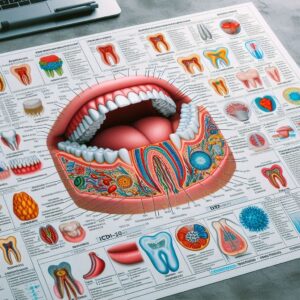ICD-10 for Dental Diseases
The International Classification of Diseases, 10th Revision (ICD-10), is a globally recognized system for coding medical and dental diagnoses. Developed by the World Health Organization (WHO), it provides a standardized way to classify diseases, including oral health conditions, ensuring uniformity in medical records, insurance claims, and epidemiological research.
For dental professionals, accurate ICD-10 coding is crucial for:
-
Insurance billing and reimbursement
-
Patient record management
-
Tracking oral health trends
-
Legal and regulatory compliance
This guide will explore the most common dental diseases, their corresponding ICD-10 codes, and best practices for implementing them in a dental practice.

2. Importance of Accurate Dental Coding
Using the correct ICD-10 codes ensures:
✔ Faster insurance claims processing
✔ Reduced claim denials
✔ Improved patient care coordination
✔ Better data for public health research
Miscoding can lead to delayed payments, audits, and even legal issues. Therefore, dental professionals must stay updated with the latest ICD-10 revisions.
3. Common Dental Diseases and Their ICD-10 Codes
A. Dental Caries (Cavities)
Dental caries, or tooth decay, is one of the most prevalent oral health issues.
| Condition | ICD-10 Code |
|---|---|
| Dental caries, unspecified | K02.9 |
| Early childhood caries | K02.5 |
| Arrested dental caries | K02.3 |
B. Periodontal Diseases
Gum diseases range from mild gingivitis to severe periodontitis.
| Condition | ICD-10 Code |
|---|---|
| Gingivitis | K05.0 |
| Chronic periodontitis | K05.3 |
| Aggressive periodontitis | K05.2 |
C. Tooth Abscess and Infections
Abscesses require immediate attention to prevent systemic infections.
| Condition | ICD-10 Code |
|---|---|
| Periapical abscess | K04.7 |
| Periodontal abscess | K05.21 |
D. Malocclusion and Jaw Disorders
Misaligned teeth and jaw issues often require orthodontic intervention.
| Condition | ICD-10 Code |
|---|---|
| Malocclusion, unspecified | K07.9 |
| Temporomandibular disorder | K07.60 |
E. Oral Mucosal Lesions
These include ulcers, leukoplakia, and oral thrush.
| Condition | ICD-10 Code |
|---|---|
| Oral candidiasis (thrush) | B37.0 |
| Aphthous ulcer (canker sore) | K12.0 |
4. How to Use ICD-10 Codes in Dental Practice
-
Step 1: Identify the patient’s diagnosis accurately.
-
Step 2: Select the most specific ICD-10 code available.
-
Step 3: Document the code in electronic health records (EHR).
-
Step 4: Submit claims with the correct codes to insurers.
Pro Tip: Always verify codes with the latest ICD-10-CM (Clinical Modification) updates.
5. Challenges in Dental Coding and How to Overcome Them
-
Challenge: Keeping up with frequent code updates.
Solution: Subscribe to dental coding newsletters or use coding software. -
Challenge: Insurance denials due to incorrect coding.
Solution: Double-check codes before submission.
6. Updates and Revisions in ICD-10 for Dental Conditions
The CDC and WHO periodically update ICD-10 codes. For example:
-
New codes for rare oral conditions
-
Revisions to existing codes for clarity
Always refer to the official ICD-10-CM manual for the latest changes.
7. Case Studies: Applying ICD-10 Codes in Real Dental Scenarios
Case 1: Severe Periodontitis with Bone Loss
-
Diagnosis: Chronic periodontitis (K05.3)
-
Treatment: Scaling and root planing (D4341)
Case 2: Periapical Abscess Requiring Root Canal
-
Diagnosis: Periapical abscess (K04.7)
-
Treatment: Root canal therapy (D3310)
8. FAQs on ICD-10 Dental Coding
Q1: What is the ICD-10 code for a routine dental check-up?
A: There is no specific ICD-10 code for a check-up. Use Z01.20 (Encounter for dental examination without complaint).
Q2: How often are ICD-10 codes updated?
A: Minor updates occur annually, while major revisions happen every few years.
Q3: Can one dental condition have multiple ICD-10 codes?
A: Yes, depending on severity and complications (e.g., K02.9 for unspecified caries vs. K02.5 for early childhood caries).
9. Conclusion
Accurate ICD-10 coding is essential for efficient dental practice management, insurance processing, and patient care. By staying updated with the latest codes and best practices, dental professionals can minimize errors and maximize reimbursement.


